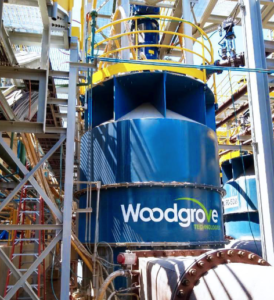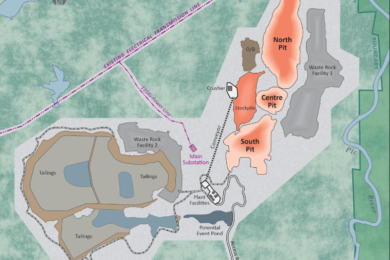Generation Mining Ltd has announce the results of the feasibility study for the Marathon palladium and copper project located near the town of Marathon in northwestern Ontario. It supports an open pit mining operation with a robust rate of return over a 13-year mine life. In the first three years of production following commercial production it is set to create C$979 million of free cash flow and produce 588,000 oz of palladium and 122 M lbs of copper from approximately 270,000 t of Cu-Pd concentrate shipped.
Generation Mining owns an 80% interest in the project, with the remaining interest owned by Sibanye-Stillwater which also has certain back-in rights that allow it to increase its interest in the project to 51% in certain circumstances and subject to certain conditions. The feasibility study has not yet been approved by the Joint Venture management committee and Sibanye-Stillwater and as a next step, Sibanye-Stillwater and the management committee are planning to review it. It was prepared by G Mining Services Inc (GMS), along with contributions from Ausenco Engineering Canada Inc, Haggarty Technical Services (HTS), Knight Piésold Ltd, WESC Inc and P&E Mining Consultants Inc.
Mining methods will employ conventional open pit, truck and shovel operating practice. Three pits will be mined over the 13-year mine life, with an additional two years of pre-production mining to be undertaken where waste material is being mined for construction and ore stockpiled ahead of processing plant commissioning. The mining equipment fleet is to be owner-operated and will include outsourcing of certain support activities such as explosives manufacturing and blasting. Production drilling and mining operations will take place on a 10 m bench height. The primary loading equipment will consist of two hydraulic face shovels (29 m3 bucket size) and one large front-end wheel loader (30 m3 bucket size). The loading fleet is matched with a fleet of 13 x 216 t haulage trucks. A fleet of two 90 t excavators will be used to excavate the limited volume of overburden material and will also be allocated to mining of the narrow-thickness ore zones associated with the W-Horizon in the South Pit to mitigate additional dilution.
Mining production at peak capacity is 40 Mt per year (110,000 t/d). Total material moved over the life of the operation is 447 Mt with 118 Mt of ore mined. The Marathon deposit is well defined and characterised by ore outcropping on surface, wide, and moderately dipping mineralised zones. The open pit operation includes a waste rock dump immediately to the east of the open pits and an ore stockpile (peak capacity of approximately 12 Mt) to the west of the pits, proximal to the crusher location.
The project process design is based on the optimised flowsheet as determined by operational considerations and the 2020 metallurgical test programs. The process plant is designed to operate at 9.2 Mt per year (25,200 t/d) and will produce a copper-palladium concentrate for marketing. The process plant flowsheet includes a conventional comminution circuit consisting of a SAG mill, pebble crusher followed by a ball mill (SABC). The flotation portion of the process plant includes rougher flotation, concentrate regrind and three stages of cleaning. After the initial construction phase, the palladium-scavenger (PGM-Scavenger) circuit will be installed and including cyclone classification of rougher tailings to reject the fine fraction and submit coarser fractions to additional regrinding and PGM scavenger flotation. The PGM-Scavenger circuit will add incremental recovery improvement to achieve the recoveries established in the 2020 metallurgical testing programs.
The flotation circuit design incorporates Woodgrove Direct Flotation Reactors (DFRs) which it says provide decreased power consumption and improved operational performance. Concentrate thickening, concentrate filtering, tailings thickening, water management, and a Tailings Storage Facility (TSF) complete the flowsheet.

The TSF design methodology includes downstream constructed embankments using run-of-mine rockfill with embankments founded directly on bedrock. The majority of the TSF area consists of exposed bedrock with a thin intermittent layer of sand and gravels. The upstream face of embankments includes an HDPE Geomembrane to minimise seepage. The construction methodology includes for bulk material placement with the mining fleet. Directly associated with the TSF is robust water management facilities that are deemed to support the operation and the robust environmental stewardship.










